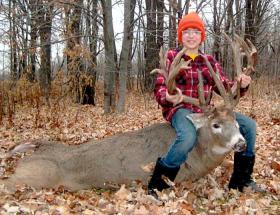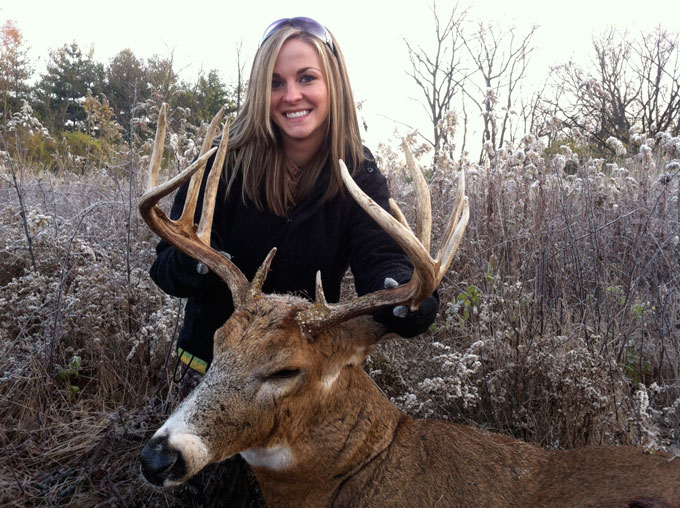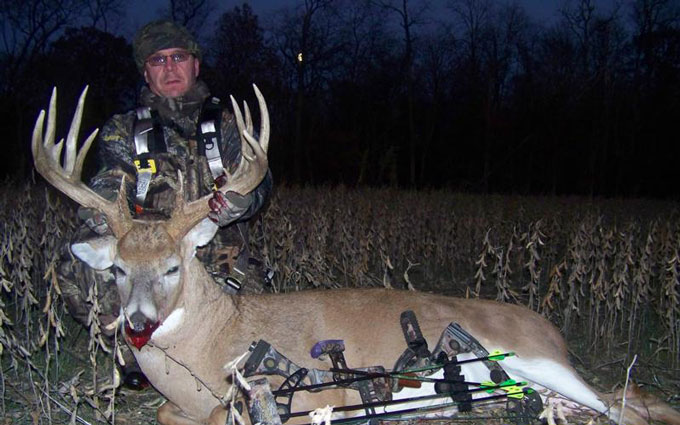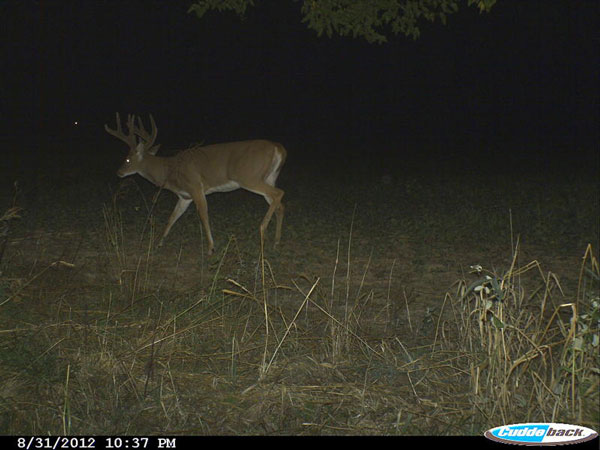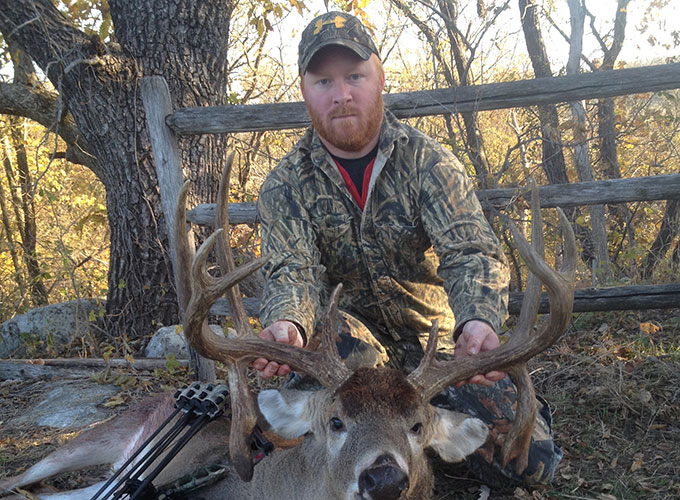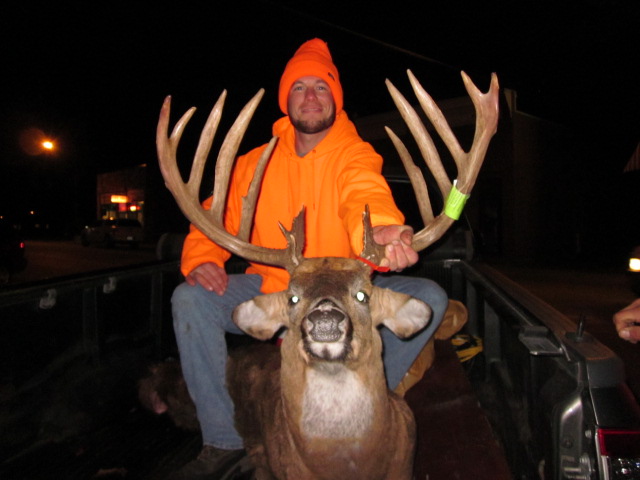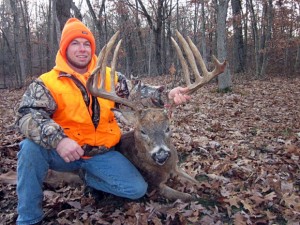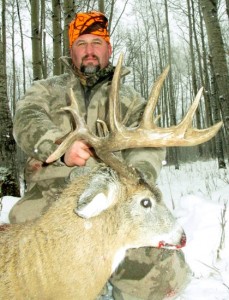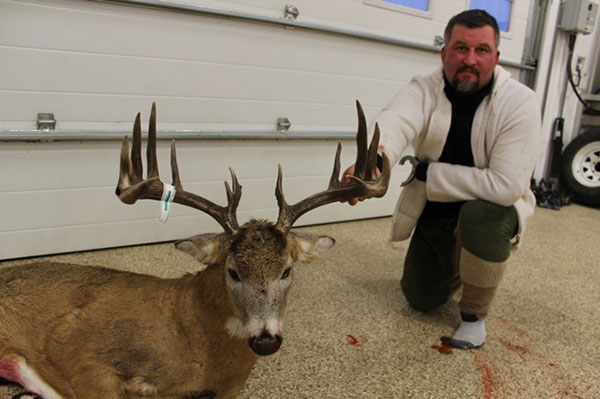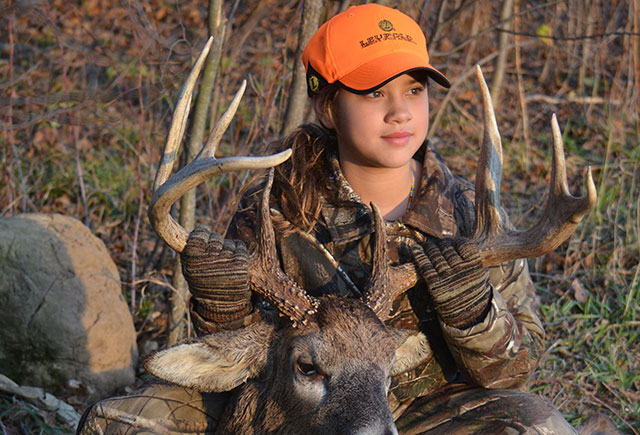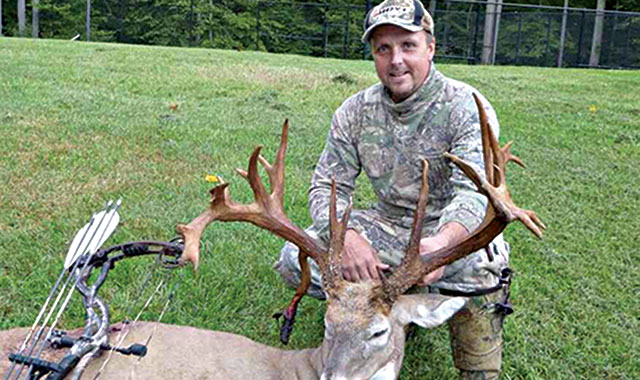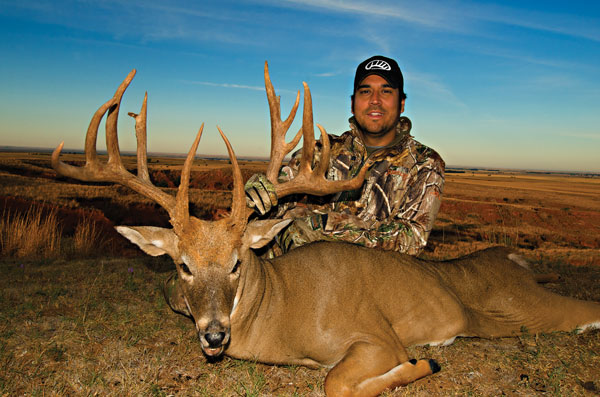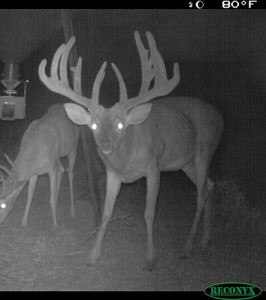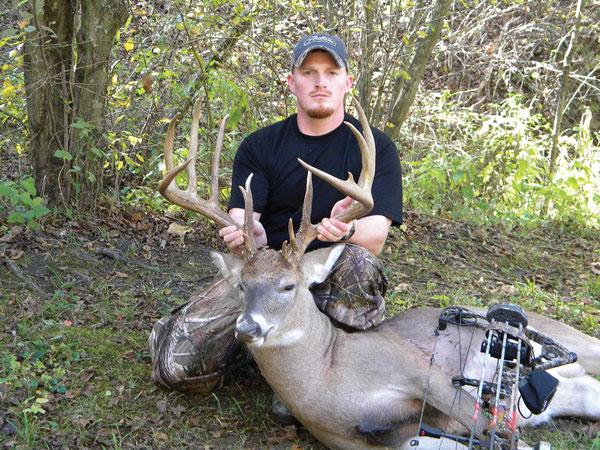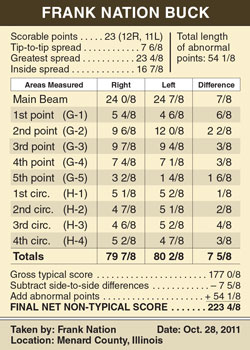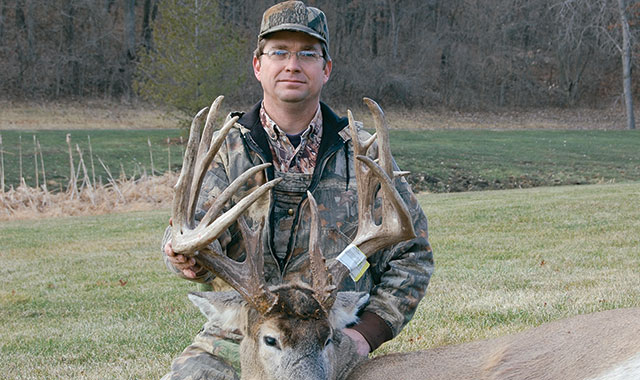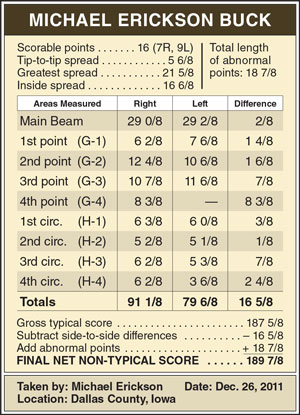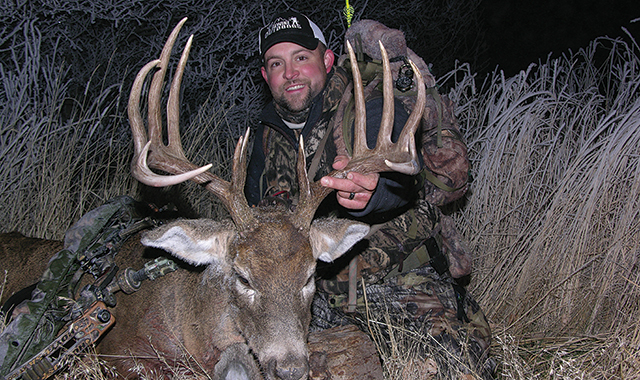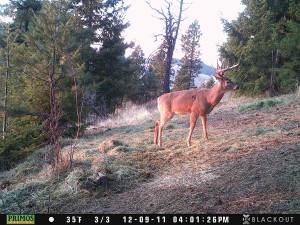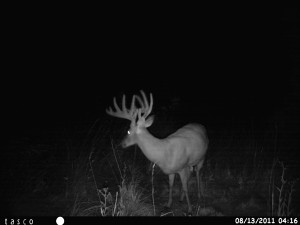![NAWP_130100_P907]() The story of this buck starts back in 2007 on an early October morning. I was bowhunting with my brother-in-law, who was filming my hunt on a small, 50-acre tract of private property in Scioto County, Ohio. On our way back to the truck that morning we spotted a big 10-pointer walking a fence line beside an overgrown pasture toward a known bedding area, but we were unable to get the camera out and on him in time to get any footage. While driving home, my brother-in-law and I discussed what we both thought the buck would score, and we both figured he’d go close to 150 inches.
The story of this buck starts back in 2007 on an early October morning. I was bowhunting with my brother-in-law, who was filming my hunt on a small, 50-acre tract of private property in Scioto County, Ohio. On our way back to the truck that morning we spotted a big 10-pointer walking a fence line beside an overgrown pasture toward a known bedding area, but we were unable to get the camera out and on him in time to get any footage. While driving home, my brother-in-law and I discussed what we both thought the buck would score, and we both figured he’d go close to 150 inches.
I’ve been hunting this 50-acre property for 10 years now, and it is a favorite spot of mine because I’ve taken a couple of good bucks over the years of hunting there and always see numerous bucks on it year after year. I figured I’d have a good chance of seeing the buck again.
The acreage has a pinch point or bottleneck of oaks that sits right in the middle of property. There are soybean and corn fields 400-500 yards away on one side and a thick bedding area of blown down timber and overgrown brush on the other. The deer feed in the agricultural fields at night and then make their way back through the pinch point feeding on acorns on their way back to the bedding area. The pattern is the opposite in the evenings.
About a week later, my brother-in-law and I were again hunting in this pinch point, and at about 9:20 a.m. I spotted two bucks feeding on acorns and heading our way. As I looked through my binoculars I could tell one of the bucks was a small 8-point and the other was the big 10-point we had seen last week. I told my brother-in-law to get the camera ready.
After about 10 minutes, the 8-point worked his way right by our stand at 20 yards and down into the thick bedding area, but the big 10-point was still about 75 yards away feeding on acorns. He continued to work our way, but I could tell he wasn’t going to come on the same trail that the 8-point had taken. He was on a trail about 35 yards out from the stand.
After a few minutes, the buck worked into my shooting lane and I released an arrow and shot over his back, hitting a tree behind him. I was disgusted with myself and didn’t know what to say to my brother-in-law but, “I’m sorry. That was the one we wanted and I just blew it.”
After going home and watching the video of the hunt, we figured without a doubt the buck would score in the 150s. I knew this was the buck that I was going to try to harvest that season.
Over the next few weeks I saw some smaller bucks and no sign of the big 10-point. Around the second week of November in 2007, I broke a bone in my left shoulder at work, and it kept me from hunting the rest of that season.
In late February and early March of 2008, I began looking for the sheds off the big 10-pointer I had missed back in October, but I was unable to find them. I was just hoping that he had made it through the hunting season. After missing half of the 2007 archery season, I could hardly wait to get out in a tree stand in 2008.
As usual, I continued to hunt the pinch point where I had missed the big 10-point at least once a week in the 2008 season, but I only saw some smaller bucks. I ended up harvesting a 163-inch 10-point on November 9 on a different piece of property that year.
Again, in February and March of 2009, I continued to hunt for the sheds off the 10-point from the year before, hoping he was still alive, but I was still unable to find them.
As in years past, I continued to stick with my usual routine and hunted the pinch point at least once a week in the 2009 season. I saw a couple of decent bucks in there that would have scored in the 130s or 140s. By this time, I figured the big 10-point from 2007 had been killed by another hunter on neighboring property or he had been hit by an automobile.
I thought I knew the 50-acre piece of property like the back of my hand since I had been hunting it for so long now, but there was one small area that I had overlooked. After scouting and hunting for sheds in February and March 2010, about 200 yards from the pinch point I found an area of huge rubs along some thick cover about 100 yards from a known bedding area. Just outside the thick cover was a small patch of white oaks that I never paid much attention to in the past because they were so close to the bedding area. But after seeing all of the big rubs and scrapes from the fall I marked a tree that I thought would be good for this coming fall.
The area was fairly easy for me to access and the only problem would be making sure I only hunted it on a southwest wind; any other wind direction would blow straight into where the deer were bedding or the direction they were coming from.
I continued on with my scouting and later I came across a big shed antler with a sticker point coming off of its base on a hill that was in between the thick bedding area and the pinch point I usually hunt. After looking it over, I guessed that if the other side would match up close to it, it would be a buck that would score in the 160s or better. I spent a couple more hours looking for the other side, but only found a couple other small sheds.
While looking for the other side, I found a crossing going through a small creek below the pinch point that I had never noticed before. It had some big tracks in it that went toward the thick bedding area with all the big rubs. I told myself that this would be a good place to set up a trail camera this summer to see if I could get picture of the buck whose shed I had just found. After I got home, I continued to look over the shed, and after a few minutes, I noticed that it resembled the big 10-point I’d missed back in 2007. I quickly went to my computer and pulled up the video of the hunt. After watching the video a couple of times, it was clear that this was indeed the same buck. He had the exact same frame with only more mass and a big sticker point off of his base.
I kept watching the video over and over, asking myself where in the world this buck could have hidden out for the past two and a half years now.
In late June I placed a trail camera just back off of the crossing in the creek I’d found with all the big tracks in it, and as I was riding out on my four-wheeler, I noticed an antler hanging in a fork of a tree about 4 feet off of the ground. To my surprise, when I removed it from the tree, it was a match to the big shed I found back in late winter.
On my way back to my truck I stopped and asked the landowner if he had placed the shed in the tree, and he stated that while he was cutting up fire wood he had found the antler. He placed it in the tree and was going to tell me about it the next time he saw me but had forgotten about it.
With both sheds in hand, there was no doubt that this was definitely the buck I’d missed in 2007, and he had put on more than 25 inches since then. He had big, bladed brow tines, one of which was split, so I decided I’d name him “Blade.” I couldn’t wait to see how big he was this year.
I began to check the trail camera on the creek crossing every three weeks in the middle of the day and was getting several pictures of different bucks. A couple of bucks would score in the 130s, and one buck was a big 14-pointer with split brow tines. He would probably score in the 160s or better.
However, over the next couple of months, I never did get a picture of the buck I named Blade. Since it seemed like every buck on the property was using this creek crossing, I believed that he wasn’t living there. I figured he was staying in a small thicket not too far from the agricultural fields.
![NAWP_130100_P909]() The month of September was dry and the soybeans were already turning yellow and starting to dry up. The oaks were starting to drop acorns and I was getting trail camera pictures of different bucks that I hadn’t seen before. I continued to get pictures of the big 14-point, but still none of Blade. All of the trail camera pictures I was getting of the 14-point had him coming from the area where I found all the big rubs in the evenings just after dark and in the mornings just before daybreak. It was going to be hard to convince myself not to hunt that area, but I knew I had to be patient and wait until the conditions were perfect.
The month of September was dry and the soybeans were already turning yellow and starting to dry up. The oaks were starting to drop acorns and I was getting trail camera pictures of different bucks that I hadn’t seen before. I continued to get pictures of the big 14-point, but still none of Blade. All of the trail camera pictures I was getting of the 14-point had him coming from the area where I found all the big rubs in the evenings just after dark and in the mornings just before daybreak. It was going to be hard to convince myself not to hunt that area, but I knew I had to be patient and wait until the conditions were perfect.
I’ve learned from past experience that the worst thing you can do is rush in and take a chance on a mature buck busting you because you couldn’t hold back and wait on the right wind direction. I believe without a doubt that the very first time you hunt a stand is the best time and after that he’ll know you’ve been there and your chances of harvesting that buck decrease tremendously.
The first evening of the 2011 season I hunted the usual pinch point and had a 130-inch 10-pointer that I had several trail camera pictures of come by my stand at less than 20 yards, along with a couple other smaller bucks. I hunted it again on Thursday morning, September 30, and had the same 130-inch 10-point and a small 8-point come in right under my stand just after day break and feed on acorns for 45 minutes.
At about 11 a.m. that morning it began to rain and the wind was beginning to blow 20-30 mph out of the southwest, so I decided to climb down out of my stand and slip up into the area where I found the big rubs back in late winter for a little scouting. After spraying down again with Scent Killer, I began to slowly slip up toward the small patch of white oaks where I had marked a tree back in the winter, glancing ahead with my binoculars to see if I could spot any deer feeding on the abundance of acorns on the ground.
As I approached the area, I quickly noticed that it was torn up again with fresh scrapes and some really big, fresh rubs. Some of small trees were broken completely in half, and acorns were everywhere on the ground. It was, without a doubt, the perfect staging area for bucks, and I knew the big 14-pointer was using this area based on the trail cam pictures that I had. With so much fresh sign, I was convinced that I needed to be in there the first chance that I got when the wind was right.
The following Tuesday, October 5, it was pouring down rain in the afternoon and I decided that with the rain masking my scent this would be a good time for me to slip into the staging area and hang a lock-on stand on the tree I had marked instead of trying to hunt it out of my climbing stand.
After hanging the stand, I noticed while slipping out that there were several more big, fresh rubs that hadn’t been there the previous Thursday. I paid close attention to the weather forecast over the next couple of days, and it looked like Saturday morning, October 9, was going to be in the low 40s with the wind out of the southwest. I happened to have that day off from work. With all the big fresh rubs, scrapes and feeding sign I’d seen in there, I couldn’t wait until Saturday morning.
The weather was just as predicted that Saturday morning—clear skies, 41 degrees, with a light wind out of the southwest—and I arrived at my stand about 45 minutes before day break and got settled in. About 15-20 minutes after daybreak, I noticed a doe behind me feeding at about 50 yards. She fed slowly down a trail that went right beside my tree and eventually up the hill toward the thick bedding area.
As I watched her go up the hill I caught some movement toward the thick cover to my right that had all the big rubs around it, and I noticed a small 6-pointer walking just outside the thicket. He was acting a little nervous and kept looking back into the thick cover. At this time, I spotted another buck walking through the thicket. When he came into the oaks, I recognized him as a 9-point, 130-class buck that I had pictures of.
The two bucks began to feed on acorns about 50 yards from my stand. After about five minutes or so, both bucks became very alert and began staring into the thick cover, and then the small buck ran and stopped just behind my tree, continuing to stare towards the ticket. I noticed another deer was coming through the thick cover, but it was coming in on a different trail than the other two bucks used. The deer had stopped right behind a big shag bark hickory tree that was about 60 yards away, right on the edge of the thicket.
I lifted up my binoculars slowly, not wanting to spook the small 6-point, which was right at the base of my tree feeding now. Looking through my binoculars I could tell that it was a good buck with long tines. I then slowly reached for my bow and positioned myself for a shot. After about a minute or so, the buck walked out from behind the hickory tree and was coming straight toward me. I knew without a doubt he was a shooter.
He walked about 30 yards, then stopped and began feeding on acorns. He only had to walk about another 5 yards for me to be able to take a shot at him. After what seemed like forever, he began to slowly walk into my shooting lane. I was trying not to look at his rack. He gave me just a slight quartering to shot at 25 yards, and I released my arrow. I knew that I had made good shot on him as I saw the arrow bury right behind his shoulder. As he turned to run off, I saw big sticker points coming up off the bases of his antlers.
I listened for him to crash in the thick brush but didn’t hear anything. I sat down in my stand and began to replay everything in my mind. I knew I had made a good shot, but I should have heard the buck go down. I sat there and gathered my composure and looked at my watch. It was 7:56 a.m.
I told myself I was going to wait about 45 minutes before I got down, retrieved my arrow and started looking for blood. As I sat there, I began to think about the buck’s rack as he ran off and told myself there isn’t another buck that I know of on this property with those sticker points other than Blade.
I just laughed to myself and said, “How in the world didn’t I get a trail camera picture of him?” As I sat there and waited in my stand, the first person I called was my wife, Alisha, and I told her I had just shot my best buck and that I thought it was the big shed buck I call Blade. She gets a lot of credit for putting up with my whitetail addiction, and she knows I have a great passion for bowhunting.
After calling my wife, I called my parents, Debbie and Larry. They have always supported my passion of hunting, and I wouldn’t be the bowhunter I am today if it wasn’t for my Dad. He was the one who got me started hunting at around the age of 10, and although he doesn’t bowhunt, I’ve watched him my whole life have a passion for rabbit hunting and running his beagles that is second to none. He always told me that part of hunting is just putting your time in and enjoying every minute of it. I can’t thank him enough for all of his encouragement over the years.
At around 8:45 a.m., I slowly climbed down my tree and walked over to where the buck was standing when I shot him and spotted my arrow. It was soaked with blood and I began slowly tracking the blood in the direction I saw the buck run off. After walking only about 20 yards or so, the blood trail was sparse with only a few small drops here and there.
I thought to myself, This buck should be pouring blood with the shot I put on him with a two-blade Rage broadhead. I stood there a few minutes to gather my thoughts and told myself to only go about another 40 yards to where I had last seen the buck in the thicket and if the blood trail doesn’t pick up by then, back out and come back later with some help. I started quietly walking in the direction I had last seen the buck and the blood trail was getting better.
As I approached the spot where I had last seen him, I noticed a white belly laying just up the hill about 30 yards. He had gone a little less than 100 yards. As I approached him, I knew this was the buck of a lifetime, and as I knelt down in front of the buck, lifting his rack, I began to thank God for such an opportunity. It was a feeling that I had never had before in all of my years of hunting. It was almost unreal.
It was indeed the buck I had named Blade and I began asking myself again how he managed to get by me unseen for over two and a half years. Apparently he knew a little more about this piece of property than I did, and as I was trying to pattern him, he had patterned me and he was more than likely there the whole time. He had learned from my mistake back on that early October morning in 2007, when I missed him.
Blade’s rack is a mainframe 12-point with 19 scoreable points and 16 6/8 inches of abnormal growth. After the mandatory 60-day drying period, Boone & Crockett and Buckeye Big Buck Club official scorer Dave Haynes of Jackson, Ohio, scored Blade at 198 6/8 gross non-typical inches with a final net score of 192 4/8 non-typical.
×
Aaron Milliken
Aaron Milliken caught up with this massive Kansas whitetail after repeated attempts to track down the 194-inch trophy. For the details, make sure to check out NAW's Deer of the Day entry..
Bill Winke
Bill Winke has earned himself a spot as one of the best Midwestern whitetail hunters of all time, with a recent buck to prove it. To read more about this massive double G4 Iowa giant, check out NAW's Deer of the Day entry.
Bo Cocannouer
Two years ago Bo Cocannouer fell from a treestand fracturing his back. Most hunters aren’t lucky enough to walk away from a twenty-foot fall, and the ones that do don’t normally get to hunt from one ever again. But Cocannouer did just that, and he came home with this 194 gross non-typical Oklahoma buck.
For more, read the rest of the story in this Deer of the Day entry.
Brian Herron
Brian Herron fought numerous obstacles and setbacks in 2012 to bag this 184-inch bruiser. Read the full story in NAW's Deer of the Day entry.
Carter Rice
Carter Rice is another first-time hunter that had huge success in 2012. Carter killed this buck in Pettis County Mo., with his father at his side . "I had not experienced that type of excitement since my 15-year-old son Seth was that age," wrote proud dad Rusty Rice.
This photo was submitted to NAW Editor Gordon Whittington earlier this season via e-mail.
Dorothy Shaffer
Iowa native Dorothy Shaffer has only been hunting for a couple years now, but she already has the buck of a lifetime with this 196-inch giant, her second buck ever.
At about 5:30 p.m. Nov. 1, Shaffer arrowed this bruiser through both lungs, dropping it near one of her husband's stands.
For more info, check out Shaffer's Deer of the Day entry.
Dylan Beach-Bittner
Have you seen the (almost) Turdy-Point Buck?
Taking a cue from the popular folk rap song, 12-year-old Dylan Beach-Bittner, downed a 27-point Minnesota monster scoring 241 green.
For more info, check out Beach-Bittner's Deer of the Day entry.
Jeff Danker
Jeff Danker of Major League Bowhunter is no stranger to trophy bucks, and on Oct. 3 Danker proved his prowess. He killed this 183 5/8-inch typical buck in Kansas' Rice County after following him all year.
For more, read the rest of the story in this Deer of the Day entry.
Jeff Iverson
Earlier this year, Jeff Iverson killed what might be the new non-typical record for a Minnesota whitetail. This is the third season that Iverson hunted this particular buck. Two years ago, when the buck was a six-by-six typical, he missed a shot at it with his bow.
For more, read the rest of the story in NAW's Deer of the Day entry.
Jordan Dressler
On the first hunt of her lifetime, Jordan Dressler killed this amazingly wide whitetail in Iowa. Now all she has to do is hunt the rest of her days in search of another buck like this one.
For more, read the rest of the story in this Deer of the Day entry.
Josh Barnard
As a dedicated whitetailer, Josh Barnard has had his fair share of ups and downs. This year was a high point, as Barnard killed this monstrous 192-inch trophy buck in Ohio. Read the full story in NAW's Deer of the Day entry.
Joshua Earp
Joshua Earp's Georgia giant scored 187 inches green, weighing in at 235 pounds, and was a great October surprise.
"“I’ve hunted 25 years for this," Earp said. " I give all thanks to God and my father for teaching me and introducing me to this sport I’m addicted to.”
For more, read the rest of the story in this Deer of the Day entry.
Lindsay Groom
With the help of her husband, Kevin, Ohio resident Lindsay Groom scouted this buck for two weeks before coming across its path again on Nov. 7. Lindsay shot the buck with her crossbow at about 10 yards, but was unable to locate the buck.
After watching the kill shot again on film, the couple decided to track it the next morning, finding the deer just 30 yards away from where they stopped looking the night before.
For more info, check out Groom's Deer of the Day entry.
Matt Ford
Abingdon, Ill., resident Matt Ford downed this monster buck in the early evening of Nov. 4; the Knox County beast scored 219 1/8 inches green.
“I still can’t believe it. I thought my 145-inch 8-point was big until this,” Ford said. “I never thought I would see a deer this big, but getting to kill one this big never crossed my mind.”
For more, check out Ford's Deer of the Day entry.
Michael Morgan
Michael Morgan killed this amazing double drop-tine giant in Kansas. After watching in agony in 2011 as the monster buck walked just out of range, Morgan found success in his second attempt at the bruiser. Read the full story in NAW's Deer of the Day entry.
Mike Giarraputo
Mike Giarraputo set a New York state record with this 210-inch non-typical bruiser. Read the full story in NAW's Deer of the Day entry.
Mike Moran
Mike Moran's Saskatchewan buck was a dream come true for the hunter who'd spent 27 years looking for a deer of that quality. He finally got his wish on Thanksgiving day, an experience he won't forget. Read the full story in NAW's Deer of the Day entry.
Paul Keller
Having chased whitetails in Wisconsin since 1978, Marion bowhunter Paul Keller is no stranger to monster bucks, but this year was decidedly different. Keller dropped a 229 2/8-inch buck that will challenge for the top of the record books when all is said and done.
For more, read the rest of the story in this Deer of the Day entry.
Payton Mireles
Payton Mireles, age 10, of Ind., killed her first buck in 2012, a 154-inch bruiser. Read the full story in NAW's Deer of the Day entry.
Pete Alfano
After a two-year quest to track down the massive deer known as "Mufasa," Pete Alfano finally struck gold with this 215-inch Kansas buck. Read the full story in NAW's Deer of the Day entry.
Randy Walk
It's pretty safe to say Randy Walk, president of Hoyt Archery, knows a thing or two about bowhunting.
Nevertheless, the 225-inch Kansas beast shared by Hoyt's Facebook page stands alone as the biggest buck he'd ever seen, he said.
“He is a giant buck. Eighteen points total with nine on each side. He has been green scored at 225 inches and some change and is clearly the largest whitetail deer I have ever seen on the hoof or on the ground for that matter."
For more info, check out Walk's Deer of the Day entry.
Richard Buker
Richard Buker has been hunting his family's property in Vermillion County, Ind., for over 20 years, and on Oct. 28, he finally got the buck of a lifetime.
That windy evening, he spotted the massive 170-inch buck working the treeline before heading across the field toward him. At 35 yards, Buker stopped the buck with a grunt, placed his shot perfectly behind the shoulder and squeezed off a shot. After running 75 yards, the buck then dropped within sight.
For more info, check out Buker's Deer of the Day entry.
Robert Gramoll
Robert Gramoll killed his 202-inch Juneau County, Wisc., record in 2012. Having deliberated about staying for the last evening of rifle season, Gramoll doesn't regret that he did. Read the full story in NAW's Deer of the Day entry.
Stanley Suda
Southern Ohio turned in another giant earlier this season when Stanley Suda shot this buck which is estimated between 235 and 240 inches.
"The shot was perfect," he said. "I watched my dream buck run across the field and pile-up about 20 yards inside the wood line. This was definitely my finest moment in the treestand.”
For more, read the rest of the story in this Deer of the Day entry.
Travis Trimmer
Travis Trimmer of Varina, Va., killed this monster buck on Oct. 27 with a crossbow at 15 yards. The brute weighed in around 159 lbs. and was reported to have a 27-inch wide inside spread.
For more, read the rest of the story in this NAW Community entry.
Picture 1 of 26
NAW's Best Bucks of 2012
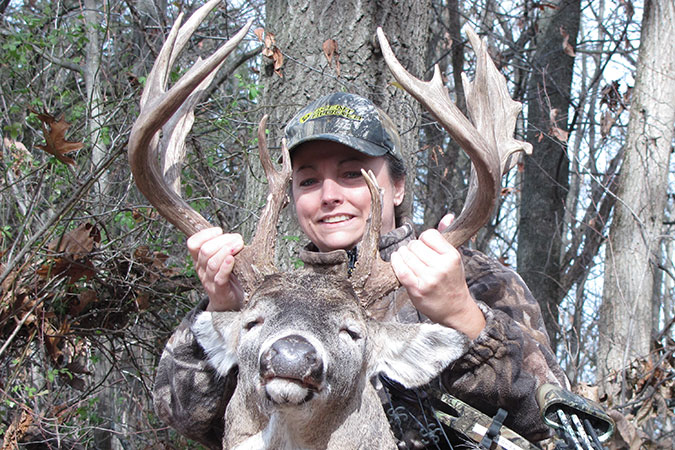 Hunter: Dorothy Shaffer
Hunter: Dorothy Shaffer










































